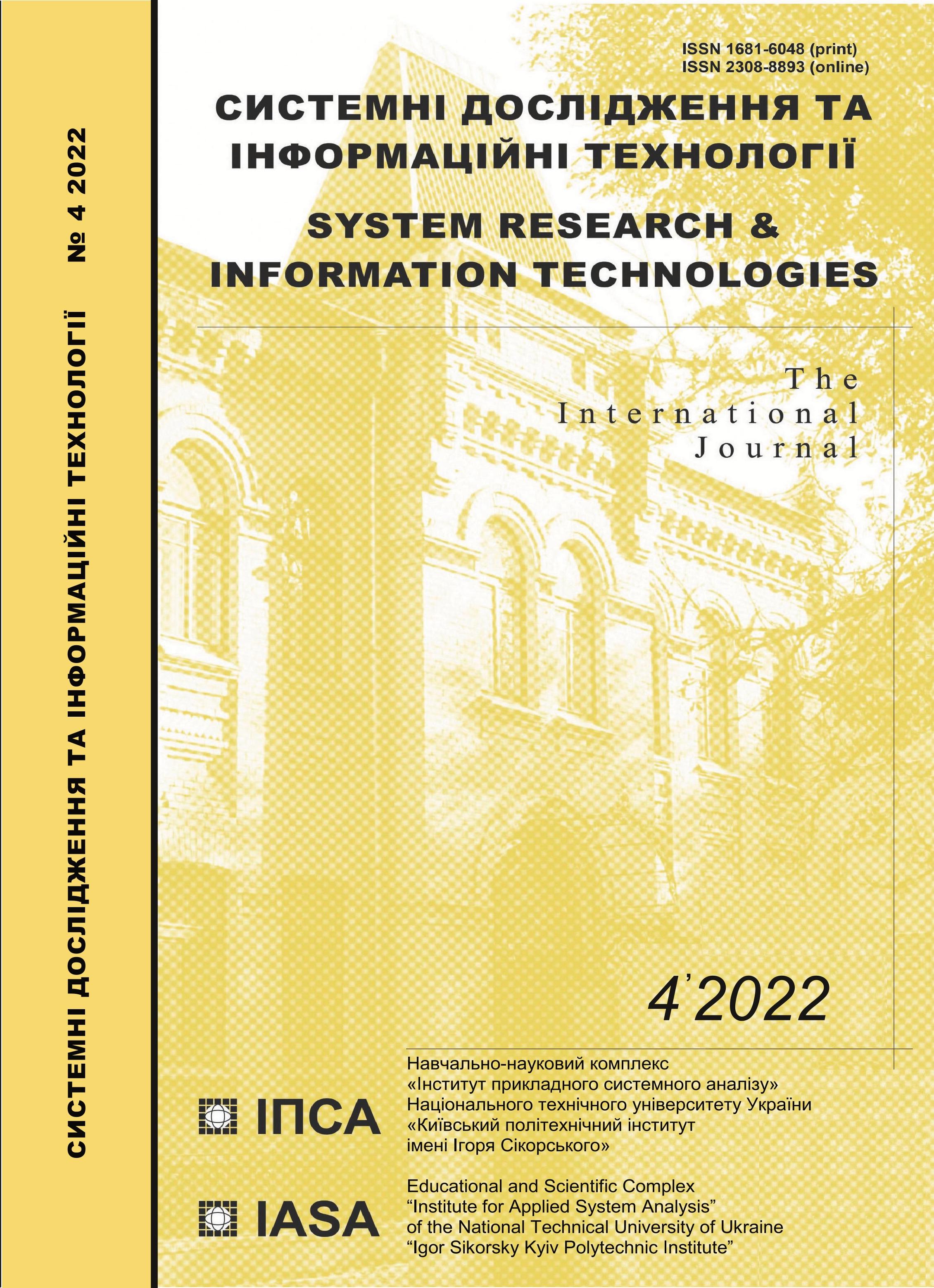Clusterization of vector and matrix data arrays using the combined evolutionary method of fish schools
DOI:
https://doi.org/10.20535/SRIT.2308-8893.2022.4.07Keywords:
combined optimization, fuzzy clustering, evolutionary algorithms, density functions, Fish SchoolAbstract
The problem of clustering data arrays described in both vector and matrix forms and based on the optimization of data distribution density functions in these arrays is considered. For the optimization of these functions, the algorithm that is a hybrid of Fish School Search, random search, and evolutionary optimization is proposed. This algorithm does not require calculating the optimized function’s derivatives and, in the general case, is designed to find optimums of multiextremal functions of the matrix argument (images). The proposed approach reduces the number of runs of the optimization procedure, finds extrema of complex functions with many extrema, and is simple in numerical implementation.
References
G. Gan, Ch. Ma, and J. Wu, Data Clustering: Theory, Algorithms and Applications. Philadelphia, Pennsylvania: SIAM, 2007, 455 p.
J. Abonyi and D. Feil, Cluster Analisis for Data Mining and System Identification. Basel, Birdhouses, 2007, 303 p.
R. Xu and D.C. Wusch, II - Clustering. Hoboken, N.J.: John Willey Sons, Inc., 2009, 341 p.
C.C. Aggarwal, Data Mining: Text Book. Springer, 2015.
A.P. Engelbrecht, Computational Intelligence An Introducion. John Willey& Sons, 2007, 597 p.
L. Rutkowski, Computational Intelligence Methods and Techniques. Berlin Heidelberg: Springer-Verlag, 2008, 514 p.
A. Kroll, Computational Intelligence. Eine Einfürung in Problelme, Methoden and Tchnische Anwendungen. München: Oldenbourg Verlag, 2013, 428 p.
T. Kohonen, Self-Organizing Maps. Berlin: Springer, 1995, 362 p. doi: 10.1007/978-3-642-56927-2.
A. Hinneburg and D.A. Keim, ”An efficient approach to clustering in large multimedia databases with noise,” Proc. 4th Int. Conf. in Knowkedge Discovery and Data Mining (KDD 98), N.Y.: AAAI Press, 1998, pp. 58–65.
A. Hinneburg and H.-H. Gabriel, ”DENCLUE 2.0: Fast clustering based on kernel density estimation,” Proceedings of the 7th International Symposium on Intelligent Data Analysis, New York: Springer Science + Business Media, 2007, pp. 70–80. doi:10.1007/978-3-540-74825-0_7.
A. Hinneburg and D.A. Keim, ”A general approach to clustering in large databases with noise,” Knowledge and Information Systems, 5 (5), pp. 387–415, 2003.
H. Rehioni, A. Idrissi, M. Abourezq, and F. Zegrary, ”DENCLUE-IM: A new approach for big data clustering,” Procedia Computer Science, 83, pp. 560–567, 2016.
E. Parzen, ”On estimation of a probably density function and mode,” The Annals of Math Statistics., 33, no. 3, pp. 1065–1076, 1962.
E.A. Nadaraya, ”On nonparametric estimation of density function and regressiion curves,” Theory of Probab. Appl., 10, pp. 186–190, 1965.
G.S. Watson, ”Smooth regression analysis,” Sankhya: The Indian Journal of Statistics, Ser. A., 26, no. 4, pp. 359–372, 1964.
J. Kennedy and R. Eberhart, ”Particle swarm optimization,” Proc. IEEE Int. Conf. on Neural Networks, Perth, Australia, 1995, pp. 1942–1948.
A. Eiben and J. Smith, Introduction to Evolutionary Computing. Heidelberg: Springer, 2003.
A.P. Karpenko, ”Population algorithms for global continious optimization,” Review of new and little-known algorithms. Supplement to the journal ”Information Technologies” №7/2012, 32 p.
C.J.A. Bastos-Filho, F.B. Lima Neto, A.J.C.C. Lins, A.I.S. Nascimento, and M.P. Lima, ”Fish School Search,” Nature-Insperiod Algorithms for Optimization. Berlin Hedelberg: Springer Verlag, 2009, SCI 193, pp. 261–277.
Jr. G.M.Cavalcanti, C.J.A. Bastos-Filho, F.B. Lima Neto, and R.M.C.S. Castro, ”A hybrid algorithm based on fish school search and particle swarm optimization for dynamic problems,” Proc. Int. Conf. in Swarm Intelligence (ICSI), 2011, vol. 2, pp.543–552.
A. Janecek and Y. Tan, ”Feeding the fish-weight update strategies for the fish school seach algorithm,” Lecture Notes in Computer Scince. Berlin Heidelberg: Springer-Verlag, 2011, vol. 6729, Part II, pp. 553–562.
L.A. Rastrigin, Random search in adaptation processes. Riga: Zinatne, 1973, 132 p.
Y.E.P. Box, “Evolutionary operation: A method for increasing industrial productivity,” Applied Statistics, 6, pp. 81–101, 1957.
W. Spendley, G.R. Hext, and F.R. Himswath, “Sequential application of simplex design in optimization and evolutionary operation,” Tehnometrics, 4, pp. 441–461, 1962.
J.A. Nelder and R. Mead, “A simplex method for function minimization,” Computer J., 7, pp. 308–313, 1965.

